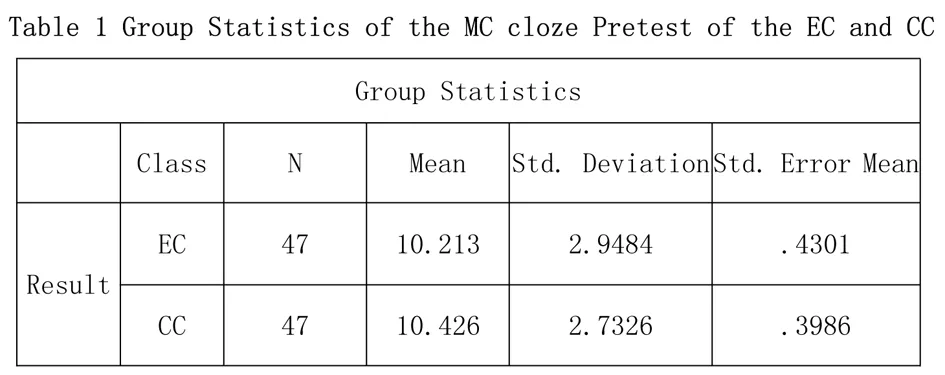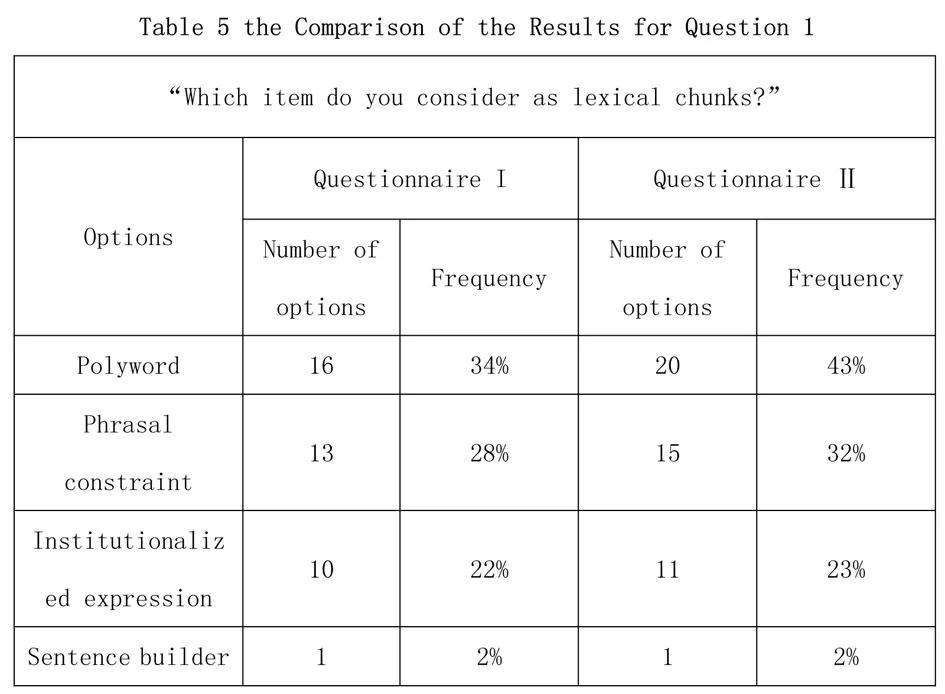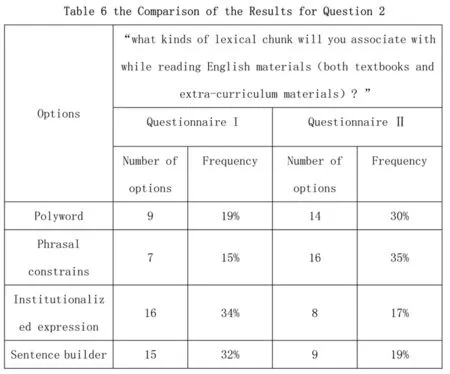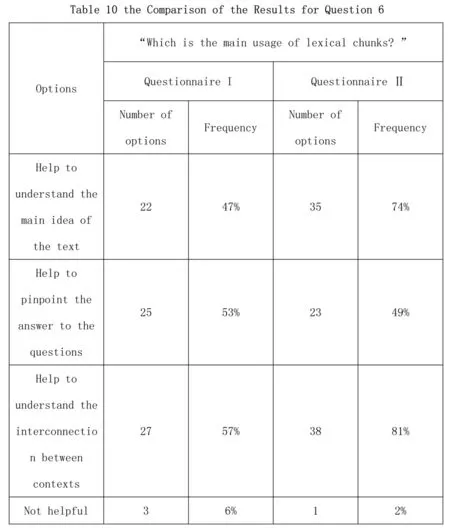An Experimental Study on the Effect of Reading-based Lexical Approach on Cloze Test Performance
2016-03-10沈博文
◆沈博文
(广州大学)
An Experimental Study on the Effect of Reading-based Lexical Approach on Cloze Test Performance
◆沈博文
(广州大学)
It is proposed by previous researches that lexical chunks are the minimum units of language input, storage and output, which possess both lexical and grammatical character, they can be taught and retrieved as a whole to improve language comprehension and production. Lexical approach is about how lexical chunks should be applied to language teaching, and has provided a new perspective for English learning and teaching in senior high school. Cloze test, recognized by western researchers of testing as being able to measure learners' comprehensive language performance, is also a language task very daunting for learners to tackle. Therefore, this study attempts to apply lexical approach to English reading teaching and observe if students' cloze performance can be enhanced and their vocabulary learning strategies be positively enriched. The results show that they have acquired chunking strategiesin their language learning and their cloze performance has been positivelyinfluenced by their retrieving of multi-word prefabricated chunks.
juniorhigh middle school clozetest lexical chunklexical approach
Cloze test has always been regarded as a vital means to test junior high students’ integrative language ability, also a commonly used form of exercise for foreign language learning. However, cloze test is also considered as one of the most complicated skills to acquire. A plethora of Chinese learners find it a daunting task, one reason being the rote learning of vocabulary which focuses on individual words instead of chunks, which is identified by the present author's preliminary investigation. Therefore,it is necessary to help the students to retrieve vocabulary knowledge effectively and read from context, thus a new teaching approach is needed.
Given the present situation in English cloze test and research gap concerning lexical chunks, the research aims to find out whether the application of lexical approach in junior high school cloze test teaching can help improve the learners' English cloze test performance.
Cloze testis playing an increasingly important role in English teaching as well as inforeign language ability assessment.According to the New National English Curriculum Standards for juniorhigh school English teaching, the chief goal of learning English is to gain integrative language ability; cloze test performanceis arecognized form to measure learners'integrative language ability.
Considering the present situation of English cloze test teaching, it is high time for teachers in senior schools to explore new ways to improve their cloze testteaching. Lexical chunks approach provides a new approach to teaching and learning English. However, the previous studies on lexical chunks mainly focused on theoretical description or empirical study on the effectiveness of the approach on writing.As discussed above, thisstudy is dedicated to find out whether a chunk approachwill effectively improve students'integrative language competence, andfurthermore, to extend the researchers and ESL teachers'understanding towards chunk-based pedagogy.
Lewis put forward "grammaticalized lexis"and made a clear statement that they were "identifies the rule and formulafor non-lexical words, the ability of collocatingsemantically strong words, evenlonger multi-word units, for example,institutionalized sentences, requires not the sameand analogue teachingtreatment".He modified the connotation of lexicon from single words to the collocation of many ritualized bits of language, asserting that "lexis is different kinds of multi-word chunks, which are word chunks connected by grammar rules"and"when combined, produce continuous coherent text".
Lexical chunks have been akey and important research topic in recent years and it has drawn many linguists'attention. Many researches have been conducted on the lexical chunks. Like Hukuta , a Japanese researcher,proves that early and timelyacquisition of premade chunks is beneficial for language users to boost their comprehensivelanguage ability.Yorio,an American linguist,claims lexical chunks can be used to boost adults’language output and serve as an effort and-attention-saving speaking strategy for adults.Peters,a researcher who focuses on developing meaning-chunk-extracting ability of child in the course of conversations,his paper revealthat lexical chunks can be storedand possessed and serve as antoolto analyze new lexical chunks in new contextual environment. Rod Ellis,a researcher who is dedicated to the application of lexical chunks in daily classroom activities, claimsthat the communicative function of lexical chunks combined with frequent application in daily learning, it should suffice the commencement of language acquisition.
In domestic academic circle, the lexical chunks are also a heat research topic.Lexical chunks are first known to domestic researchers with the introduction of Yang Yuchen.He says lexical chunks are very common in written English and it is worth paying enough time to conduct research.Shen Minyu gives the basic introduction oflexical chunksand its basic teaching guidance to Chinese researchers. Li Hongclaims thatlexical chunks is efficient on the improvement of students’ language production.Qi Yan argues thatlexical chunks can boost students’ writing competence,promote the production of idiomatic language.Liu Jiaying states lexical chunks can exert great influenceon boostingstudents' oral competence. Mao Chengyiexploresthe daily application of lexical chunks by English learners interms ofconversational English. Theresearch result provesthat the applicationof lexical chunks in different groups shows great contrast in terms oftypes of lexical chunksapplied, and thehigh performance students have made better progress in making fluent dialogue.
Cloze was firstly created and used by Tyler in "cloze procedure"in 1953,which was originally used to measure the readability of the material. Taylor found that the test can not only test students' reading comprehension, but also test students' inner knowledge of grammar.So he suggested that a cloze test can be used to test people's reading comprehension level.Later,some scholars further expanded the scope of application of the cloze test in second language learning, to evaluate the level of language knowledge of second language learners. Cohen found that the cloze test has a very high correlation with reading comprehension, writing, listening and speaking skills, so he thought the cloze test was an effective method to test the overall language proficiency of the students.
Researchers from home and abroad take cloze procedure very seriously, which give clue to the popularly of cloze test in English exams, both formal and informal.Chinese scholars consider cloze procedures as an effective way of measuring students' integrative English competence.Liu Runqing, Han Baocheng,Wu Zunmin and many other researchers in their book studied the writing principle, the test form and scoring method in detail.
The research questionsare as follows:(1)Does Lexical approach have positive effect on junior middle school students’ cloze test performance?(2)Has Lexical approach positively influenced junior middle school students’ vocabulary strategies in English learning?
In this experiment the subjects consisted of 94students who came from two neutralized classes in a junior middle school in Guangzhou. Before this experiment, they shared similar English studying experience and were taught by the same teacher under the same teaching system.
The independent variable of this experiment is reading-based lexical approach; the dependentvariables are the students'cloze performance tested by MC cloze tests and their vocabulary strategies in English learning measured by questionnaires. The control variablesinclude teaching hours,text book, teacher, students' initialEnglish proficiencyincluding theirrespective level of reading comprehension and cloze test performance before the experiment.
MC cloze was used to test students' cloze test performance. The author used a pre-test and a post-test in both experimental class and control class.The pre-test was to investigate whether the two classes of subjects are at the same level of cloze test performance.The post-test was carried out to measurewhether the students' English cloze test performancehas really been improved after employingthe Lexical approach. All of the MC cloze appeared in pre-test and post-test are chosen from authentictest papers of high school entrance examination in recent years. Each MC cloze test includes 20 test items, eachtest item will be graded 1 score, ifcorrect.
Two questionnairesare administeredto subjects in this experiment.In order to achieve maximum reliability, both of the questionnairesare written in Chinese.The questionnaires are designed to compare the differenceof subjects'attitude towards vocabulary strategiesin completing clozetest.The questionnaire2 includes the same questions as questionnaire 1, theonly difference is that the order of the questions is changed. The intentionof the questionnaire design is meant for comparingthe results to answer researchquestion 2.
At the beginning of the experiment,a pre-testwas conducted inboththe experimental classand the control class. The pre-test was employedto check whether the cloze test performance of the students from EC and CC are the same or not. A questionnaire is also handed out to students to learn their knowledge and understanding of lexical chunks, reading habits, after the pretest,the result showed that both the resultsof EC and CC were virtuallythe same.
During the experiment, the two classes adopteddifferent teaching approaches. Lexical approach was employed in the experimental class, while the conventional way ofcloze test teachingwithout emphasis on lexical chunks was used in the control class which featuredas: firstly,the students were required to read the textof the article and then the students were requested to give the proper answers to relevant questions concerning some complex grammatical phenomena andmeaning of some difficult words of the text raised by the author.The teaching material applied in the experiment for both EC and CC were the same which was Oxford EnglishTextbook 7B and 8A by Shanghai Education Press.(Guangzhou Edition), the teaching progress of both classes were the same.Lexical approach was employed in the experimental class, the steps of which are as follows: firstly, the author present new lexical chunks in the text to students; Then let the students study new lexical chunks in reading the text.Thirdly consolidate the lexical chunks by various exercises. After that, theauthor will let students apply the newly-learned lexical chunks, and further understand the text. Rightthen, the author introducesdifferent types of lexical chunks to students and tell them the powerful functions of lexical chunks. Next the author gets the students to pay attention to the different categories of lexical chunks in the cloze test.Inthe end,the author getsstudents to apply the newly learned lexical chunk to write a short passage. At the end of the experiment, students were requiredto take a post-test of MC cloze test. Comparisons were made to see whether the lexical approach has advantages in promoting students' cloze test performance.
Before the experiment, a MC clozepretest was conducted at the beginning of the new semester in order to compare students' English cloze test competencein the experimental class and the control class. The Independent Samples T-Test serves as a toolin the author's experimentto test the difference between the cloze test competence of EC and CC. The pre-test data is analyzed via SPSS software by running anIndependent-Samples T-Test. The results of the data analysis are listedin the following table.

In Table 1, we can see thatthe mean valueof EC is 10.213and the mean score of CC is 10.426. Although the standard deviation of CC students is a little bit higher than that of EC students, while the significant differences between EC and CC can only be testified in the Independent-Samples T-Test and the results are presentedin the following table.

Fromthe Table 2, it is easy to see that the significance of Variances Equality is .965(P>.05), which means that the variances of the two classes are equal. That is to say the data in Equal Variances assumed is valid. In table 4.6, the t-value is -.363, the significance level (2-tailed probability) is .718(P>.05). Therefore, it is obvious that before the experiment the two classes show no significant difference in terms of MC cloze testcompetence.
Results of Post-test:

From Table 3, it is obvious to see that the mean score of EC is 11.319and the mean score of CC is 9.851, which means there is a difference between the EC and CC with respect to MC cloze test performanceafter the experiment. Whether the differences between these two groups are significant or not is shown by the results of Independent-Samples T-Test in the following table.

From Table 4, it is easy to see that the significance of Variances Equality is .006(<.05), The t-value is 2.595and the significance level (2-tailed probability) is .011(<.05.). Therefore, it can be concludedthat after the experiment the two classes have significant difference interms ofEnglish MC cloze test performance.
Results of Questionnaires:

From the table 5, it can be seen that before the experiment, the students from EC will consider polyword, phrasal constraint and institutionalized expression are all lexical chunks, and then after the experiment, theproportion for the polyword, phrasalconstraint and institutionalizedexpressions considered as lexical chunkhave risen.

From the table 6 the following conclusion can be made: before the experiment, the subjects from the EC consider polyword, phrasal constraint;institutionalized expression and sentence builder will all be associated with while reading Englishmaterials. Afterthe experiment, wecan see that the proportion for polyword andphrasal constraints have raisedwhile the proportionfor institutionalized expression and sentence builder have dropped.

From thetable 7wecan see the followingchanges in students' attitudetowards lexical chunks: before the experiment students will choose to memorize institutionalized expression and sentence builderas a whole structure in daily English learning. Butafter theexperiment, they will choose to memorizepolyword and phrasal constraints instead of institutionalizedexpression and sentence builder as a whole structure in daily English learning.

As it is demonstratedin the table 8inthe questionnaire 1, the studentsfind all the four types of lexical chunks will be associatedwith while they are accomplishing reading comprehensions.Thenin the questionnaire2,the author see a huge rise in the percentage of choosing phrasal constraint and polyword. The change in the proportionlead to the following conclusion: the polyword andthe phrasalconstraints are relatively easier to rememberand recognizable than institutionalizedexpressions and sentence builder therefore lead to the rise in the number of option.

From thetable 9, itis obvious to see that: beforethe lexical chunk pedagogy infusion,most students will consider; institutionalizedexpression and phrasal constraints will be all associated with while accomplishing cloze test exercises. Itshows thatthestudents in the experimental class will choose to associate with phrasal constraints and institutionalized expression while doing Englishcloze test. But after the lexical chunk experiment, the students prefer toassociate with sentence builder and polyword while doing clozetest.

From the Table10 the author drew thefollowing conclusion: whentalking about the usage of lexical chunks in their daily English learning,around 50% students consider lexical chunk are helpfulin terms of understanding the main ideas of texts, locatingthe answers to questions and understandingthe interconnection of the contexts. Andafter the experiment,the percentage of main idea understanding and interconnection increase dramatically, whilethe other two options' percentageremain stable. The trending shows that the students of EC have realized the lexical approach can facilitate the understandingof the main idea of cloze test text.

From the Table11 the following conclusioncan be made: before the lexical approach experiment , more than half of the students have the following problemsconcerning adopting lexical approach: first: theyfound accumulation of lexical chunks were not enough ;second , the new-learned lexical chunk don't hold a lasting memory; third,the identification of lexical chunk are not easy; fourth: it is hard to analyze the logic structure in the text by applying lexical approach; then after the experiment, the author sees a huge surge in the percentage in the accumulation and the logic structure problem, whilethe percentage for the other two options have fallen.
As indicated in Table 4, the value of Sig.(2-tailed) is lower than 0.05, which proves that there is significant difference between the two classesin the scores of the MC cloze test. Since the data in Table-5.1 demonstratesthat there is no difference in pre-test, the analysis in Table-4 verifiesthat lexical approachreallyhas positive effecton students' MC cloze test performance.
It shows in Table5that the number of subjects who consider polyword as lexicalchunkis increasing. It is found that proportionof the subjects who opted for polyword as lexical chunk has increased almost 10 percent compared with the first questionnaire. The author consider the change of subjects'attitude reveals the polyword as the most fundamental type of lexical chunk is easier to be identifiedthan other types of lexical chunks.
In Table 6wecan see the followingchanges in students' attitudetowards lexical chunks: before the experiment students will choose to memorize institutionalized expression and sentence builderas a whole structure in daily English learning. Butafter theexperiment, they will choose to memorizepolyword and phrasal constraints instead of institutionalizedexpression and sentence builder as a whole structure in daily English learning. The trend of change of attitude reflect that Doing this helps them to contextualize the meaning, like taking a snapshot to store in their memory for later use.
According to the Table 7, thestudents in the EC choose polyword and phrasal constraints as the "whole structure"to be memorized.It is in compliance with Nattinger and DeCarrico's comment which they say "It is our ability to employlexical phrases that are useful forus to make fluent speech. This pre-made speech boasts of twoadvantages :one is allowingmore efficient retrieval and the second ispermitting speakers (and learners) to direct their focusto the larger structure of the discourse, instead of putting their focuson individual narrowly words as they are manufactured".
Accordingto the Table 8, the EC's subjects' responses arein line withLavelle's notion that "with all lexical chunks, students should be made aware that the meaning lies in the grouping of the words and not in the individual words.
Then according to Table 9, the subjects in the experimental class consider polyword and sentence builder will be associated with while completing cloze test.The author considers it is due to the reason that as Taylorput it" the cloze procedure has been broadly introduced to serve more than a tool of measuring text readability.With the special characteristics it possesses, it has worked as a method for assessing the degreehow students comprehend text and even as a procedure for improving reading comprehension".Since the students has acquired enough sums of lexical chunk infusion during the experiment, they see "polyword and sentence builder relatively useful in terms of improving cloze test performance.
From the Table 10 ,it can be seen that thepercentage of choosing" help to understand the main idea of the text" has risen from 47% to 74%, the percentage of choosing the option "help to pinpoint the answer to the questions"has risen from 57% to 81%.
From the Table 11, 64 percent of students consider it hard to identifylexical chunk, while the percentage dropped to 32 percent, whichmeans the EC students have greatlyimprove their identification ability after the experiment. Whilethere are still 77 percent (after the experiment)of EC studentsconsider it difficult to apply lexical chunk approach in analyzing the structure of cloze test article. The reason contributes to this phenomenon is that the EC students'extra class reading enhancementof lexical chunk is not enough to allow them to thoroughlycomprehend the logic interconnection of the cloze test article. And there are 66 percent (after the experiment) of EC students think"not enough accumulation oflexical chunks and unfamiliar usage of lexical chunks"is an obstaclethey faced in learning lexical chunks.
It shows that the experimental class can skillfully identify the lexical chunks in English cloze test. The transformations in vocabularystrategy of clozetest may be due to the reading-based lexical approach trainingin the experimental class. Therefore, reading-based lexical approachis theoreticallyand empirically supported to be effective in junior middle school classes.
Based on the above analysis, lexical approach is a very effective way to improve juniorhigh school students' performanceof English cloze test. The application of lexical approach to English cloze test teaching is very necessary. After the implementation of experimental pedagogy, some major findings can be found.
Through this experiment, it isconcluded that lexical approach hasmade some enhancementto the junior middle school students' English cloze test performance, which is mainly demonstratedin the followingaspects:
1.After the teaching experiment, the students' performance of experimental class onthe cloze test has largely improved. That means the lexical approach is beneficial to improve juniorhigh school students' English cloze test performance.
There are many advantages of lexical approach in English cloze test: 1.Words don't have direct connectionswith contexts, thus lexical chunks bridge the gap between words and contexts. If the students have been awareof the content of contexts, they can understand the clozetextmaterials easier. So the lexical approach is not only a promisingway to English cloze test, but also can enhancestudents'abilityto enlarge their volumeof vocabulary.
2.Lexical approach has positively influenced students' vocabulary strategiesin English learning.And it is an excellent approach to students to boost English cloze test pedagogyin the future.From the results of pretestand posttest, it can be concluded that students' following competence in EC has improved:(1)Guessing by context, logical clues and main idea of the sentence.(2)Guessing the strange words on the basis of their already known knowledge.(3)To identifythe grammatical properties of the word and phrases, of being able to choose the right missing partof thecollocation correctly and of knowing its written form.Thus, we can say,it can be easily concluded that using the lexical approach can improve students' vocabulary strategies.
As has been stated above, the lexical approach is an effective try at English vocabulary teaching in senior high school. After the teaching experiment, the author has got some pedagogical implications for English cloze test teaching.
1.Teachers should change their traditional teaching ideas.
2.Teachers should proactivelytrain the students’ sensitiveness aboutlexical chunks.
[1]Cohen, A.C.Testing Language Ability in the Classroom. Rowley[M].MA: Newbury House,1980.
[2]Decker, R.Windows on the U.S.A.(500 word level) [M].Chicago, IL:Science Research Associates,1982.
[3]Ellis,R.Classroom second language development [M].Oxford: Pergamon Institute of English,1984.
[4]Ellis, R.Understanding Second Language Acquisition [M].Oxford:Pergamon Institute of English,1985.
[5]Ellis, R.The Study of Second Language Acquisition [M]. Oxford: Oxford University Press,1993.
[6]Hakuta, K. Becoming bilingual:A case study of a Japanese child learning English[M]. Language Learning,1976,(26):321-351.
[7]Lewis, Michael.Pedagogical Implications of the Lexical Approach [M].Cambridge University Press,1997.
[8]Lewis, Michael.The Lexical Approach [M].Hove:Language Teaching Publications,1993.
[9]Lewis.lmplementing the Lexical Approach: Putting Theory in Practice [M].Hove: Language Teaching Publications,1997.
[10]M.Blue & R. Mitchell (eds.).Language and Education (British Studies in Applied Linguistics 11) [J] Clevedon:Multilingual Matters,1995.
[11]Morley, J. and Partington, A. A few Frequently Asked Questions about semantic-or evaluative-prosody [M].International Journal of Corpus Linguistics,2009,14 (02):139-158
[12]Nattinger J. R. & DeCarrico J.S Lexical Phrases and Language Teaching [M].New York: Oxford University Press,1992.
[13]Peters,A. The units of language acquisition[M].Cambridge University Press,1983.
[14]Richards, Jack C. and Rodgers, Theodore S. Approaches and Methods in Language Teaching. (2nd edition) [M].Cambridge:Cambridge University Press,2001.
[15]Richards,J. C. & Rodgers,T. S. Approaches and Methods in Language Teaching. (2nd edition) [M].Beijing Foreign Language Teaching and Research Press and Cambridge University Press,2008.
[16]Taylor, W. L.Cloze procedure: A New Tool for Measuring Readability[M].Journalism Quarterly, 1953,(30):415-433.
[17]Yorio, C.Conventionalized language forms and the development of communicative competence[J].TESOL Quarterly, 1980,(14):433-42.
[18]何国伟,华维芬.完形测试中的评分问题[J].现代外语,1995,(02):31-33.
[19]江艳.词汇组块教学在初中英语教学中的应用[D].华东师范大学,2007.
[20]金木.完形填空能作为整体语言能力测试手段吗[J].国外外语教学,1993,(04):20-24.
[21]李莜菊.语言测试的科学和艺术[M].湖南:湖南教育出版社,2001.
[22]李建仓.浅析完形填空的特点和应试技巧[J].教育与职业,2006.
